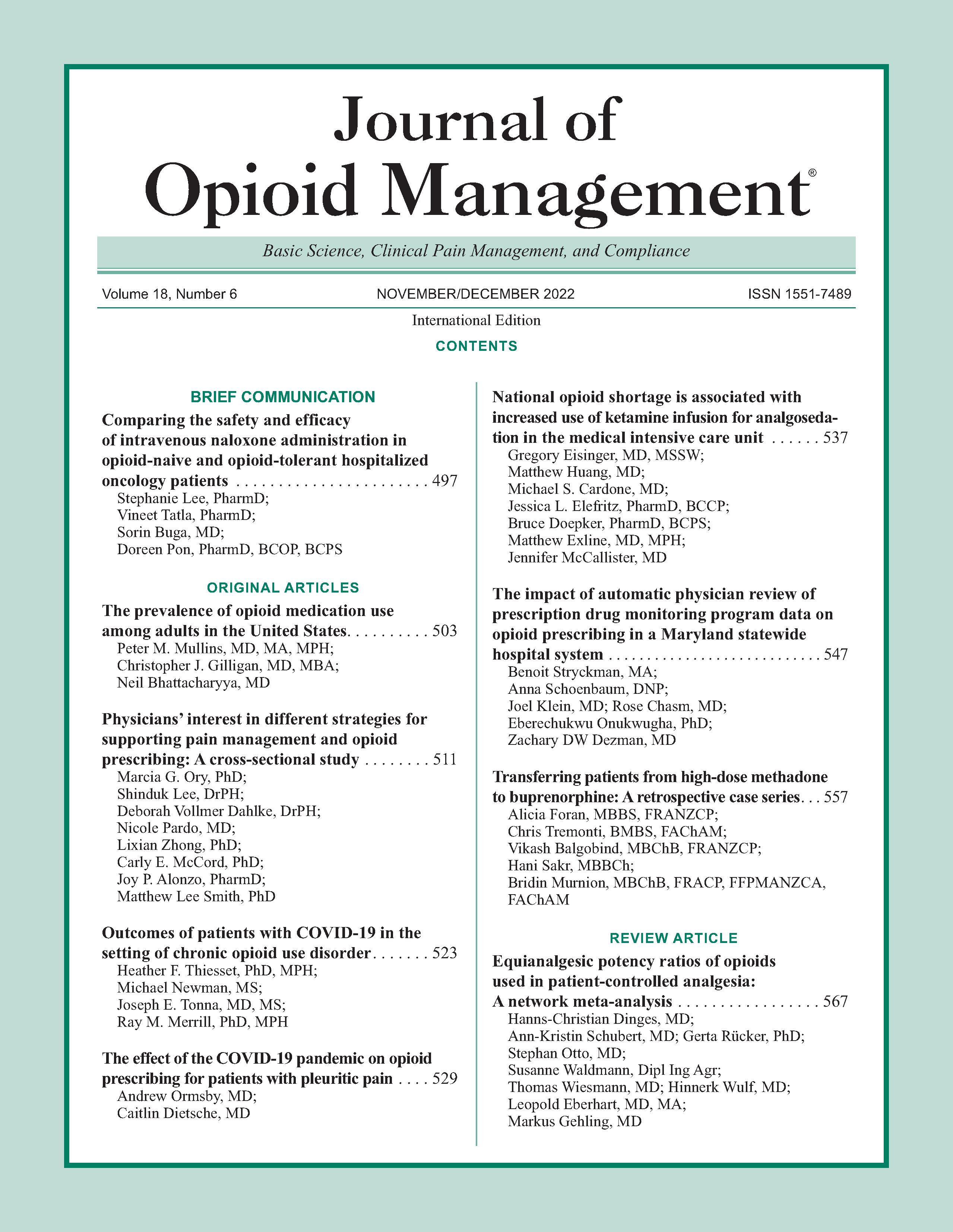National opioid shortage is associated with increased use of ketamine infusion for analgosedation in the medical intensive care unit
DOI:
https://doi.org/10.5055/jom.2022.0749Keywords:
ketamine infusion, opioid shortage, analgosedation, ICU, mechanical ventilationAbstract
Objective: To assess the impact of the national shortage of injectable opioids during the winter of 2017-2018 on the use of ketamine infusion for analgosedation in the medical intensive care unit (MICU).
Design: A retrospective cohort study.
Setting: Single-center tertiary care MICU at The Ohio State University Wexner Medical Center.
Patients: All patients who received continuous infusion of ketamine to facilitate mechanical ventilation between May 1, 2015 and September 1, 2018.
Measurements and main results: Seventy-seven patients were identified during the study time frame: 43 before and 19 during the opioid shortage. During the peak of the shortage, there was a sevenfold increase in orders for ketamine infusion (2.2 patients/week vs 0.32 patients/week; p < 0.001). Median time from the start of mechanical ventilation to initiation of ketamine infusion was significantly shorter during the shortage (14.1 hours) versus before (51.2 hours; p = 0.03). There was a trend toward adding ketamine into the sedation regimen earlier during the shortage (mean number of drips added prior to ketamine was 2.74 during the shortage vs 3.3 before; p = 0.06). There was also a trend toward increased use of ketamine infusion as monotherapy during (21.1 percent of patients) versus before the shortage (7 percent), though this did not reach statistical significance (p = 0.19).
Conclusion: The national opioid shortage may have led to earlier and more frequent use of ketamine infusion for anaglosedation in mechanically ventilated MICU patients.
References
US Drug Enforcement Administration: DEA reduces amount of opioid controlled substances to be manufactured in 2017. 2016. Available at https://www.dea.gov/press-releases/2016/10/04/dea-reduces-amount-opioid-controlled-substances-be-manufactured-2017. Accessed May 10, 2019.
Hernandez M, Bigham C: FDA warning letter to Pfizer pharmaceuticals. 2017. Available at https://www.fda.gov/inspectionscompliance-enforcement-and-criminal-investigations/warningletters/hospira-inc-506761-02142017. Accessed May 10, 2019.
Wang B, Downing N: A crisis within an epidemic: Critical opioid shortage in US hospitals. Postgrad Med J. 2019; 95: 515-516. DOI: 10.1136/postgradmedj-2018-136058.
Malacos K: Drug shortages: Contributing factors, mitigating the impact. Pharm Times. 2019. Available at https://www.pharmacytimes.com/news/drug-shortages-continue-to-be-achallenge.
American Society of Health Systems Pharmacists: Injectable opioid survey report. 2018. Available at https://www.ashp.org/Drug-Shortages/Shortage-Resources/Injectable-Opioid-Survey-Report. Accessed May 10, 2019.
Hemmings HC, Egan TD: Pharmacology and Physiology for Anesthesia: Foundations and Clinical Application. Amsterdam, The Netherlands: Elsevier Health Sciences, 2013. DOI: 10.1016/C2009-0-41712-4.
Li L, Vlisides PE: Ketamine: 50 years of modulating the mind. Front Hum Neurosci. 2016; 10: 612. DOI: 10.3389/fnhum.2016.00612.
Niesters M, Aarts L, Sarton E, et al.: Influence of ketamine and morphine on descending pain modulation in chronic pain patients: A randomized placebo-controlled cross-over proof-of-concept study. Br J Anaesth. 2013; 110(6): 1010-1016. DOI: 10.1093/bja/aes578.
Peltoniemi MA, Hagelberg NM, Olkkola KT, et al.: Ketamine: A review of clinical pharmacokinetics and pharmacodynamics in anesthesia and pain therapy. Clin Pharmacokinet. 2016; 55(9): 1059-1077. DOI: 10.1007/s40262-016-0383-6.
Devabhakthuni S, Armahizer MJ, Dasta JF, et al.: Analgosedation: A paradigm shift in intensive care unit sedation practice. Ann Pharmacother. 2012; 46(4): 530-540. DOI: 10.1345/aph.1Q525.
Barr J, Fraser GL, Puntillo K, et al.: Clinical practice guidelines for the management of pain, agitation, and delirium in adult patients in the intensive care unit. Crit Care Med. 2013; 41(1): 263-306. DOI: 10.1097/CCM.0b013e3182783b72.
Miller AC, Jamin CT, Elamin EM: Continuous intravenous infusion of ketamine for maintenance sedation. Minerva Anestesiol. 2011; 77(8): 812-820.
Kolenda H, Gremmelt A, Rading S, et al.: Ketamine for analgosedative therapy in intensive care treatment of head-injured patients. Acta Neurochir. 1996; 138(10): 1193-1199. DOI:
1007/BF01809750.
McGhee LL, Maani CV, Garza TH, et al.: The correlation between ketamine and posttraumatic stress disorder in burned service members. J Trauma Acute Care Surg. 2008; 64(Suppl): S195-S199. DOI: 10.1097/TA.0b013e318160ba1d.
Pizon AF, Lynch MJ, Benedict NJ, et al.: Adjunct ketamine use in the management of severe ethanol withdrawal. Crit Care Med. 2018; 46(8): e768-e771. DOI: 10.1097/CCM.0000000000003204.
Goyal S, Agrawal A: Ketamine in status asthmaticus: A review. Indian J Crit Care Med. 2013; 17(3): 154-161. DOI: 10.4103/0972-5229.117048.
Fang Y, Wang X: Ketamine for the treatment of refractory status epilepticus. Seizure. 2015; 30: 14-20. DOI: 10.1016/j.seizure.2015.05.010.
Lange M, Bröking K, Van Aken H, et al.: Role of ketamine in sepsis and systemic inflammatory response syndrome. Anaesthesist. 2006; 55: 883-891. DOI: 10.1007/s00101-006-1048-x.
Li K, Yang J, Han X: Ketamine attenuates sepsis-induced acute lung injury via regulation of HMGB1-RAGE pathways. Int Immunopharmacol. 2016; 34: 114-128. DOI: 10.1016/j.intimp.2016.01.021.
Strayer RJ, Nelson LS: Adverse events associated with ketamine for procedural sedation in adults. Am J Emerg Med. 2008; 26(9): 985-1028. DOI: 10.1016/j.ajem.2007.12.005.
Wang X, Ding X, Tong Y, et al.: Ketamine does not increase intracranial pressure compared with opioids: Meta-analysis of randomized controlled trials. J Anesth. 2014; 28(6): 821-827. DOI: 10.1007/s00540-014-1845-3.
Drayna PC, Estrada C, Wang W, et al.: Ketamine sedation is not associated with clinically meaningful elevation of intraocular pressure. Am J Emerg Med. 2012; 30(7): 1215-1218. DOI: 10.1016/j.ajem.2011.06.001.
Premier Inc.: More than 96 percent of health systems report moderate to severe shortages of injectable narcotics. Available at https://www.premierinc.com/newsroom/press-releases/morethan-96-percent-of-health-systems-report-moderate-to-severeshortages-of-injectable-narcotics. Accessed June 26, 2019.
Haider A, Qian Y, Lu Z, et al.: Implications of the parenteral opioid shortage for prescription patterns and pain control among hospitalized patients with cancer referred to palliative care. JAMA Oncol. 2019; 5: 841-846. DOI: 10.1001/jamaoncol.2019.0062.
Bruera E: Parenteral opioid shortage—Treating pain during the opioid-overdose epidemic. N Engl J Med. 2018; 379: 601-603. DOI: 10.1056/nejmp1807117.
Klaus DA, De Bettignies AM, Seemann R, et al.: Impact of a remifentanil supply shortage on mechanical ventilation in a tertiary care hospital: A retrospective comparison. Crit Care. 2018; 22(1): 1-8. DOI: 10.1186/s13054-018-2198-3.
Soumerai TE, Kamdar MMC: The other opioid crisis: Just another drug shortage? Oncologist. 2019; 24(5): 574-575.
Published
How to Cite
Issue
Section
License
Copyright 2005-2025, Weston Medical Publishing, LLC and Journal of Opioid Management. All Rights Reserved.











